Relationships, Routines & Rethinking the Lesson Transcript
GFX:
Teaching Channel
+++ 00:00:05 +++
Jeremy Yager: I cannot tell you how many of these kids walked in at the beginning of the year, telling me that math was their least favorite subject and they knew they were going to fail. And these same kids are the ones who have grown two to three years, in part because they have teachers who believe in them and push them and in part, just because they've worked their tails off throughout the year.
Card:
Creating Success in
Middle School:
Relationships, Routines
And Rethinking the Lesson
+++ 00:00:32 +++
Student: Y equals 3x plus y.
Jeremy Yager: All right, so remember, our slope is the same as M.
Lower Third:
Jeremy Yager
7th Grade Math Teacher
Uplift Grand School, Grand Prairie, Texas
Jeremy Yager: Today's lesson was about calculating slope based on two points. Ideally, by the end of the lesson, they would be able to do it without needing to see the actual graph.
Jeremy Yager: So we need to put a point on the Y axis as 5.
+++ 00:00:53 +++
Jeremy Yager: They begin with a do now. So the do now today was a review of finding the slope of a line when plotting the points. And we also wanted to make sure that with the four or five scholars who were still having trouble doing that, that they would get a little bit of remediation time before we moved on to another more complicated thing.
+++ 00:01:12 +++
Jeremy Yager: We always start with the Y intercept, so put a point on the Y axis. All right, now this point is good. These two points are actually perfect. All right, guys, if you can hear my voice, clap once. Clap twice. Clap three times. What was the slope? A volunteer I haven't heard from yet. Kahari?
Student: One over two.
Jeremy Yager: Yeah, and what was our Y intercept?
Student: Two.
Jeremy Yager: Yep. What was the slope on number three? Daniella?
Student: Negative three-fourths.
Jeremy Yager: Negative three-fourths. How many of you accidentally put positive three-fourths? Yeah? Easy, easy, easy mistake to make.
+++ 00:01:46 +++
Jeremy Yager: I think that it's a good lesson to give kids that it's okay to get a problem wrong at first. It's okay to not understand something at first, because we all learn on our own different paces.
Jeremy Yager: All right, can I have a volunteer read our objective for today's lesson from the top of this page? Emily, let's go.
Student: Grizzly will be able to determine the slope of a line given two points and whether additional points fall on same line.
Jeremy Yager: All right, beautiful. Does anyone notice a key word in that objective that tells us what general idea we're going to be working with today? Guillermo.
Student: Slope.
+++ 00:02:18 +++
Jeremy Yager: Slope. We are continuing our unit of study today on slope. Today what we're going to look at specifically is how we can determine slope of a line, if we don't even have a graph to look at. Now to do that, we're going to do every eighth grader, or soon to be eighth grader's favorite thing in the entire world. We're going to watch a Brain Pop video.
Narrator: Dear Tim and Moby, how do I find a line's slope and intercept?
Jeremy Yager: They'd actually seen that video before. I kind of doubled up to get their brains back into the right state of mind.
+++ 00:02:47 +++
Narrator: Some people call that rise over run.
Jeremy Yager: After the video, we jumped into an exploration. So in the exploration, my goal was to get them thinking through the process of how they would determine slope themselves. So they had an exercise where they were actually given a graph. They were given two points and they would graph those two points and determine the slope by looking at the graph.
Jeremy Yager: Isaiah, can you read the directions for explore?
+++ 00:03:14 +++
Student: Use the information above to answer questions one through four to the best of your ability. And show your work and justify your responses in complete sentences.
Jeremy Yager: All right, does anyone have any questions about these directions?
Students: No.
Jeremy Yager: All right, I'm going to set a timer for ten minutes. I want you to attempt to answer these questions on your own. Do not worry if you cannot answer them correctly just yet. It is completely fine to get it wrong right now because we're going to figure out how to get it right together in ten minutes. Go ahead and get started. So that would be going over by one and not by two.
+++ 00:03:44 +++
Student: So you can show me how you use the triangle.
Jeremy Yager: So what does that 3 actually tell you?
Student: That would tell me the rise and then, by 3, and then 2 tells me to go up 2.
Jeremy Yager: Okay, good. You are qualified to teach problems one and two to Carlos. I want you to help him out with these.
Student: Okay.
+++ 00:04:00 +++
Jeremy Yager: Kids who are able to teach material that they've recently mastered to other students have a higher rate of mastery over time than other students. So in my opinion at least, it really ups the rigor factor for those kids.
Student: Here we have to do 10 plus 10, which is going to be 20, bottom, top...
Student: How do you know it's 10 plus 10?
Student: Ten plus 10 is 20, and then 5 plus 5 is ten, which means it's 20 over 10.
+++ 00:04:24 +++
Jeremy Yager: One of the things that I think is really important and that I'm still working on is coaching up my peer tutors, in the sense that they don't just immediately explain how to do something or just give the kids they answer.
Student: And this is why we're here, and then you've got to start one. But you got the second one first and subtracted that by 2.
Student: So you subtract it by the opposite, like they're the same side?
Student: But you just switch them though.
+++ 00:04:50 +++
Jeremy Yager: What I anticipated as being misconceptions, I anticipated issues with organization and things like that. What I didn't necessarily expect was that there would be confusion between X coordinates and Y coordinates.
Jeremy Yager: You did it upside down. Now it does work because both of them did come out to 1, but what was supposed to be your numerator?
Student: Two?
Student: The Y?
Jeremy Yager: The Y. But what did you actually put in your numerator?
Student: The X.
Jeremy Yager: You know how in slope, when we write this down, we have rise over run. Which goes on top, X or Y? Which of those? Carlos.
Student: X?
Student: Y.
+++ 00:05:24 +++
Jeremy Yager: When we say rise, are we talking about Y or X?
Jeremy Yager: I did not properly anticipate it and once it happened, it was very easy for me to see, this is where my kids are and this is what they need assistance with, and I could tailor the help that I gave them for a good solid chunk of the remaining period toward where they were individually.
Jeremy Yager: What they've been doing is they've been saying that the first number in the ordered pair is Y and the second number in the ordered pair is X. Is that true?
Students: No.
Jeremy Yager: What is the first number in the ordered pair? Armando?
Student: X.
+++ 00:05:58 +++
Jeremy Yager: Yeah, so the first number in your ordered pair is X. The second number is your what, Armando?
Student: Y.
Jeremy Yager: So I would like you to flip to the partner practice, problem number four. We mapped out "4,5," "6,8" and we continued going up by 3 over by 2, up by 3, over by 2, up by 3, over by 2. Would we eventually end up on "8,11"? What makes you think that it would not go up to "8,11".
Student: Because we tried it up here.
Student: Yeah, we tried it up there.
Jeremy Yager: What did you try?
+++ 00:06:24 +++
Student: I added the other two numbers to see if it will work, and then I did the thing that you told us to do, go over, right, up. I mean, go right wherever we have to go to and go up right away.
Jeremy Yager: These are definitely interesting thoughts. Okay, when we add 3 to 8, what do end up with?
Students: Eleven.
Jeremy Yager: Eleven. When we add 2 to 6, what do end up with?
Students: Eight.
Jeremy Yager: Eight.
Student: So you can go up to 8.
Jeremy Yager: Well, hold on. If we wanted to write this as an actual ordered pair, when you write the ordered pair, what comes first, X or Y?
Students: X.
+++ 00:06:55 +++
Jeremy Yager: X. So we would have 8 first and then 11. And hey, guess what. That's the exact point that we were looking for.
Jeremy Yager: It's really important to me and to my kids that I learn and I improve my practice every day. So today, I saw something that wasn't working to the extent that I would want it to, and I made a conscious and clear decision that I was going to salvage as much of the lesson as I possibly could and build my students towards one particular piece of mastery that we would be able to leverage as we move forward into our next lesson.
+++ 00:07:30 +++
Jeremy Yager: So plot these coordinates and then use your slope.
Jeremy Yager: When we move into the next period, we'll have more of the focus on making sure that they have long term mastery of the material, rather than just regurgitating what I or Armando was telling them today. So what we'll probably end up doing is something along the lines of an entry ticket. We'll assess what they're able to do independently at the beginning of class, during the do now next period. That will give me a good idea of the extent to which I need to spend more time on that basic concept.
+++ 00:08:01 +++
Jeremy Yager: Before we go, I want you to turn to your partner and I want you to give your partner and yourself, I want you to give you one glow for yourself today, one thing that you feel confident in determining, or solving, or one piece of work that you were good at. And I want you to give yourself one grow. In other words, one thing that you still need additional assistance with. Take 30 seconds, pack up and talk to your neighbor.
+++ 00:08:25 +++
Jeremy Yager: By holding those kids to high standards and pushing them to accomplish rigorous work and pushing them to think through problems on their own, pushing them to feel and taste success and not just grow, but begin experiencing mastery, is something that is going to yield really tangible results when it comes to pushing them to college.
GFX:
Teaching Channel
#### End of C0804_003007_Yager_Class.final_SD.mp4 ####

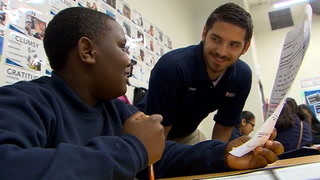
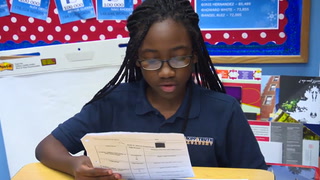

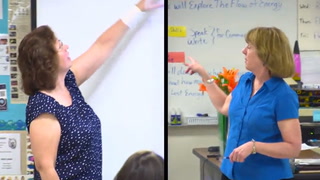


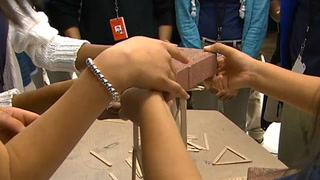
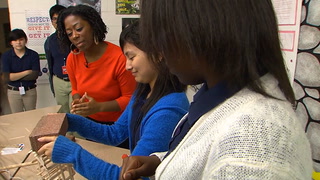


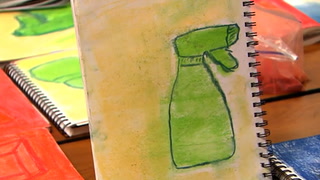
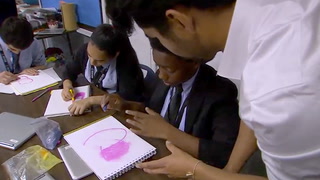
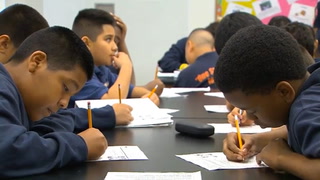
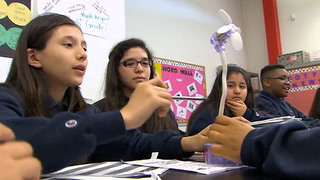









9 Comments
Alisha McCool-Kelley Jul 5, 2020 4:21pm
Steven Cooper May 19, 2020 9:20pm
What an amazing teacher. I am going to implement so many of these ideas into my future classroom.
Aundrea Gamble Apr 22, 2020 1:25pm
1. How does Mr. Yager encourage his students to learn from each other?
Mr. Yager calls on his students to give their answers, but he also lets them know that everyone learns at their own pace and its okay if you make a mistake or didn't get the correct answer. He also gives students the ability to teach their peers ways to solve the different math problems.
2. Why does Mr. Yager decide to change his lesson plan halfway through the lesson?
Mr. Yager realized where his students were after the ten minutes and decided to scale back to something they weren't quite understanding.
3. How will Mr. Yager continue building his students' underestanding of concepts after this lesson?
Mr. Yager will insert a entry ticket for each student to see who is able to do things independently during a lesson which will then give him clarification that the student is ready to move on.
Opalyn Marquez Nov 9, 2017 3:50pm
Catherine Asaolu Aug 28, 2016 12:08am